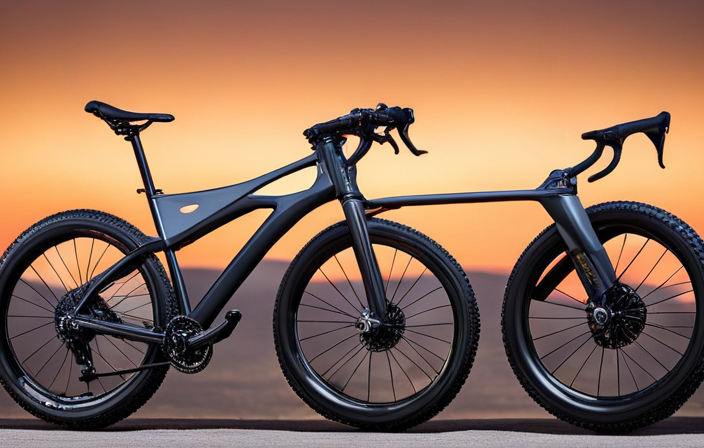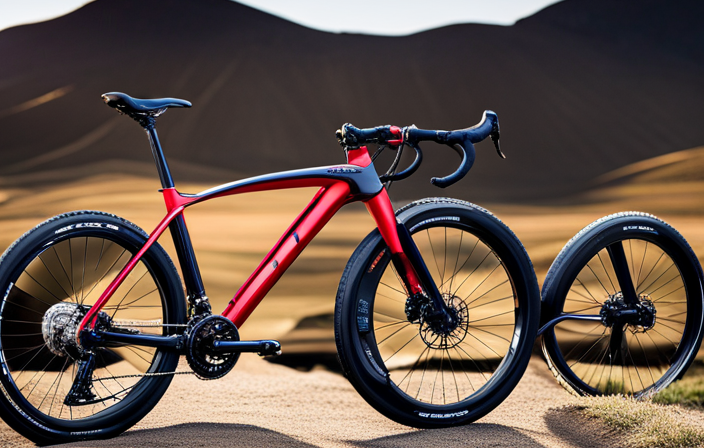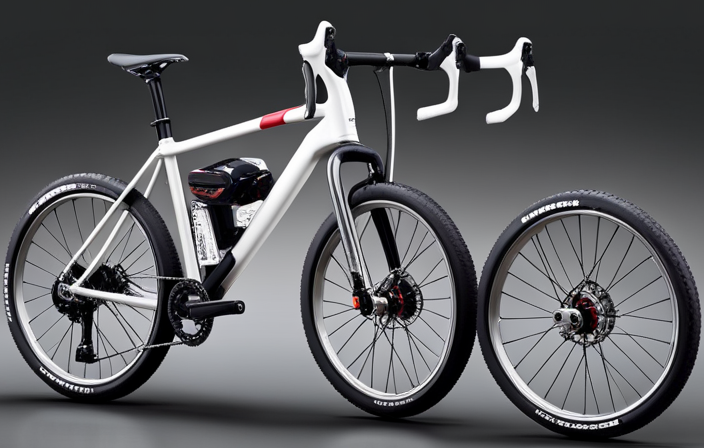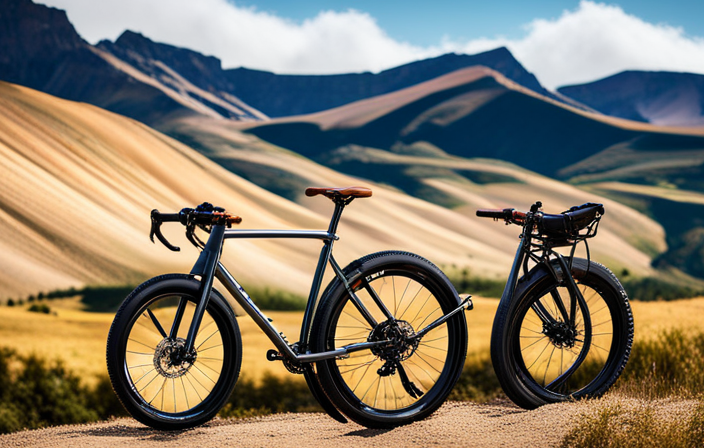Riding on gravel roads can provide a sense of excitement and adventure for cyclists. However, selecting the ideal bicycle can seem overwhelming. As a passionate cyclist, I recognize the significance of picking the perfect bicycle for navigating these demanding terrains.
In this article, I will share my expertise on what kind of bike is best suited for gravel roads. I will highlight the benefits of riding a gravel bike and provide tips on maintenance and upgrades.
Get ready to embark on your next off-road journey with confidence and excitement.
Key Takeaways
- Look for a bike with wider tires for better stability.
- Consider a bike with disc brakes for improved stopping power.
- Opt for a bike with a sturdy frame to handle rough terrain.
- New tires provide better grip and stability for off-road adventures.
The Benefits of Riding a Gravel Bike
You’ll love riding a gravel bike because it offers numerous benefits for tackling gravel roads. Gravel bikes are specifically designed to handle the challenges of off-road riding, providing riders with advantages that make them perfect for this terrain.
One of the main reasons why gravel bikes excel on gravel roads is their versatility. They are equipped with wider tires and a more relaxed geometry compared to road bikes, allowing you to tackle rough surfaces with greater ease and comfort.
Another advantage of gravel bikes is their ability to handle various types of terrain. Whether you’re riding on loose gravel, dirt paths, or even muddy trails, these bikes can handle it all. The wider tires provide better traction and stability, while the disc brakes offer reliable stopping power in any weather conditions.
Gravel bikes also come with additional features such as mounts for racks and fenders, making them great options for bikepacking adventures or commuting. Furthermore, they often have multiple gear options, which allows you to find the perfect cadence no matter the gradient or surface.
Understanding the different types of bikes for gravel roads will further enhance your riding experience.
Understanding the Different Types of Bikes for Gravel Roads
When it comes to riding on unpaved terrain, there are various types of bicycles that cater to different preferences. One important consideration when choosing a bike for gravel roads is the bike fit. It’s crucial to find a bike that fits your body properly to ensure comfort and efficiency while riding.
Gravel bikes and mountain bikes are two popular options for off-road adventures.
Gravel bikes are specifically designed for riding on rough surfaces like gravel roads. They have wider tires with more tread compared to road bikes, providing better traction and stability. Gravel bikes also have a more relaxed geometry, which means a more upright riding position that reduces strain on the back and neck during long rides.
On the other hand, mountain bikes are designed for tackling rugged trails with obstacles like rocks, roots, and steep descents. They have suspension systems that absorb shocks and bumps, allowing riders to maintain control in challenging terrains.
When deciding between a gravel bike and a mountain bike for gravel roads, consider the type of terrain you’ll be riding on. If you’ll mostly encounter loose gravel or dirt paths without technical features, a gravel bike would be suitable. However, if you plan on venturing into more technical trails with steep climbs or descents, a mountain bike might be the better choice.
Considering these factors will help you choose the right bike for your gravel road adventures—whether it’s an adrenaline-fueled ride through challenging trails or a leisurely exploration of scenic routes ahead.
Considerations for Choosing the Right Bike
To choose the right bike, think about the specific terrain you’ll be riding on for your off-road adventures. This will help determine the type of bike that is best suited for gravel roads.
When considering different options, there are two main factors to keep in mind: price range and bike fit.
When it comes to price range, it’s important to set a budget that works for you. Gravel bikes can vary greatly in price, so knowing how much you’re willing to spend will narrow down your options and prevent you from overspending.
Bike fit is another crucial consideration. A properly fitting bike will ensure comfort and efficiency during your rides. Take into account your height, weight, and body proportions when choosing the right size frame. Additionally, consider factors like handlebar width and saddle shape to find a bike that suits your individual needs.
In terms of evoking emotion in the audience:
- Safety: A well-fitted bike ensures a secure and enjoyable ride.
- Adventure: The right gravel bike opens up endless opportunities for exploration.
- Satisfaction: Finding a bike within your budget brings a sense of accomplishment.
Now that we’ve discussed considerations for choosing the right bike, let’s delve into the features to look for in a gravel bike without delay.
Features to Look for in a Gravel Bike
One important aspect to consider is the overall durability of a gravel bike. When riding on rough and unpredictable terrain, it’s crucial to have a bike that can withstand the challenges of gravel roads. There are several important components and features to look for in a gravel bike that contribute to its durability.
Firstly, the frame material plays a significant role in determining how well a bike can handle gravel roads. Many gravel bikes are made from aluminum, which offers a good combination of strength and weight. Carbon fiber frames are also popular as they provide excellent shock absorption and are lightweight. Steel frames, although heavier, are known for their durability and ability to absorb vibrations.
To help you visualize the importance of these features when choosing a gravel bike, I’ve created a table below:
| Component | Importance | Effect on Ride Quality |
|---|---|---|
| Frame Material | High | Determines overall strength and ride comfort |
| Tire Clearance | Medium | Allows for wider tires which provide better traction on loose surfaces |
| Disc Brakes | High | Offers reliable stopping power in all weather conditions |
| Suspension | Low | Absorbs shocks for smoother rides on rough terrain |
Considering these important components will ensure you choose a durable gravel bike that suits your needs. Now let’s move on to exploring some of the top gravel bikes on the market without skipping a beat.
Top Gravel Bikes on the Market
Let’s now take a look at some of the top gravel bikes available in the market. When it comes to choosing a gravel bike, there are several top brands that stand out. Some of these include Specialized, Cannondale, Giant, and Trek. These brands have a reputation for producing high-quality bikes that can handle various terrains with ease.
When considering the best tires for gravel biking, it’s important to choose ones that offer durability and grip. Brands like Schwalbe, Maxxis, WTB, and Panaracer are known for their excellent gravel bike tire options. These tires often feature wider widths and aggressive tread patterns to provide optimal traction on loose surfaces.
In summary, if you’re looking for a top-notch gravel bike, consider checking out brands like Specialized, Cannondale, Giant, and Trek. Additionally, be sure to equip your bike with high-quality tires from reputable brands such as Schwalbe, Maxxis, WTB, or Panaracer.
Now that we’ve covered some of the top gravel bikes on the market and discussed the best tires for this type of riding, let’s move on to the next section about tips for maintaining and upgrading your gravel bike.
Tips for Maintaining and Upgrading Your Gravel Bike
When maintaining and upgrading your gravel bike, it’s important to regularly clean and lubricate the chain to ensure smooth shifting and longevity.
Cleaning the chain is a simple process that can be done with a degreaser and a brush. Start by applying the degreaser to the chain, then use the brush to scrub away any dirt or grime. Rinse off the degreaser with water and make sure to dry the chain thoroughly before applying lubricant.
As for tire maintenance, it’s crucial to regularly check the tire pressure and tread wear. Proper tire pressure is essential for optimal performance on gravel roads, so invest in a good quality pump with accurate pressure gauges. Additionally, inspect your tires for any cuts or punctures, as these can lead to flats on rough terrain. If you notice significant wear on your tires, it may be time to replace them for better traction and control.
By following these cleaning tips and ensuring proper tire maintenance, you’ll keep your gravel bike in top condition for all your off-road adventures.
Frequently Asked Questions
What are the best tires for riding on gravel roads?
When it comes to riding on gravel roads, tubeless tires offer several advantages.
Firstly, they eliminate the risk of pinch flats since they don’t have inner tubes. This means you can run lower tire pressures for better traction and a smoother ride.
Secondly, choosing the right tire width is crucial for different gravel road conditions. Wider tires provide more stability and grip on loose surfaces, while narrower ones are better suited for hard-packed gravel roads.
How should I adjust my bike’s suspension for optimal performance on gravel roads?
To optimize my bike’s performance on gravel roads, I focus on adjusting its suspension and maintaining proper tire pressure.
Adjusting the suspension is crucial as it ensures better stability and control over rough terrain. By setting a slightly softer rear suspension, I can absorb bumps and maintain traction without compromising comfort.
Additionally, maintaining the right tire pressure is vital for improved grip and maneuverability on loose surfaces like gravel.
These adjustments greatly enhance my riding experience on such roads.
Are there any specific gear ratios that are recommended for gravel riding?
When it comes to gear ratios for road cycling on gravel, there are a few factors to consider.
Generally, you’ll want lower gears to handle the rough terrain and potential climbs. A compact crankset with a smaller chainring and a wide-range cassette can provide the necessary range of gears for gravel riding.
Additionally, choosing the right bike for gravel riding involves considering factors such as tire clearance, frame geometry, and suspension options if desired.
Can I use a mountain bike for riding on gravel roads, or is a gravel bike necessary?
You can definitely use a mountain bike for riding on gravel roads, but a gravel bike offers some distinct advantages.
While a mountain bike provides better off-road capability with its suspension and wider tires, a gravel bike is specifically designed for long rides on mixed terrain.
It features a more relaxed geometry for comfort, narrower tires for increased speed, and mounting points for accessories.
So, while a mountain bike will work, a gravel bike is the optimal choice for enjoying the benefits of riding on gravel roads.
Are there any specific techniques or skills I need to learn for riding on gravel roads?
When it comes to riding on gravel roads, there are a few techniques that can greatly enhance your experience.
Firstly, maintaining a relaxed grip on the handlebars will help you absorb vibrations and maintain control.
Additionally, it’s important to keep your weight centered over the bike for better stability.
As for choosing the right bike for gravel roads, consider opting for a gravel-specific bike with wider tires and more clearance to handle rough terrain effectively.
Conclusion
In conclusion, after exploring the benefits of riding a gravel bike and understanding the different types available, it is clear that choosing the right bike for gravel roads is essential.
The features to look for, such as wider tires and disc brakes, ensure a smooth and stable ride. With top brands like Specialized and Trek offering excellent options, finding the perfect gravel bike is within reach.
Remember to maintain and upgrade your bike regularly to keep it performing at its best.
So gear up, hit those gravel roads, and let your adventurous spirit soar like a flock of birds taking flight on a summer’s eve.









